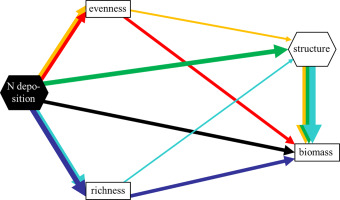Science of the Total Environment ( IF 8.2 ) Pub Date : 2018-01-12 , DOI: 10.1016/j.scitotenv.2018.01.025 Xiaobing Zhou , Matthew A. Bowker , Ye Tao , Lin Wu , Yuanming Zhang

|
Short-lived herbaceous plants provide a useful model to rapidly reveal how multiple generations of plants in natural plant communities of sensitive desert ecosystems will be affected by N deposition. We monitored dynamic responses of community structure, richness, evenness, density and biomass of herbaceous plants to experimental N addition (2:1 NH4+:NO3− added at 0, 0.5, 1, 3, 6 and 24 g N m− 2 a− 1) in three seasons in each of three years in the Gurbantunggut desert, a typical temperate desert of central Asia. We found clear rate-dependent and season-dependent effects of N deposition on each of these variables, in most cases becoming more obvious through time. N addition reduced plant richness, leading to a loss of about half of the species after three generations in the highest N application level. Evenness and density were relatively insensitive to all but the greatest levels of N addition for two generations, but negative effects emerged in the third generation. Biomass, both above and below ground, was non-linearly affected by N deposition. Low and intermediate levels of N deposition often increased biomass, whereas the highest level suppressed biomass. Stimulatory effects of intermediate N addition disappeared in the third generation. All of these responses are strongly interrelated in a cascade of changes. Notably, changes in biomass due to N deposition were mediated by declines in richness and evenness, and other changes in community structure, rather than solely being the direct outcome of release from limitation. The interrelationships between N deposition and the different plant community attributes change not only seasonally, but also progressively change through time. These temporal changes appear to be largely independent of interannual or seasonal climatic conditions.
中文翻译:

长期添加氮会诱导植物群落的级联反应,具有季节性和渐进动态
短命的草本植物提供了一个有用的模型,可以快速揭示敏感沙漠生态系统的天然植物群落中的多代植物将如何受到氮沉降的影响。我们监测群落结构,丰富度,均匀度,密度和草本植物的生物质的动态响应实验施氮(2:1 NH 4 +:NO 3 -在0℃下加入,0.5%,1,3,6和24克N-米- 2 a − 1),这是在典型的中亚温带沙漠古尔邦通古特沙漠中,每三年进行三个季节。我们发现氮沉降对这些变量均具有明显的速率依赖性和季节依赖性,在大多数情况下,随着时间的推移,这种效应会变得更加明显。氮的添加减少了植物的丰富度,导致三代在最高的氮施用水平下损失了大约一半的物种。除了最大的氮添加量外,两代均一性和密度相对不敏感,但第三代出现了负面影响。地上和地下的生物量都受氮沉降的非线性影响。低和中等水平的氮沉降通常会增加生物量,而最高水平会抑制生物量。在第三代中,中间添加氮的刺激作用消失了。所有这些响应在一系列更改中都紧密相关。值得注意的是,由于氮的沉积,生物量的变化是由丰富度和均匀度的下降以及群落结构的其他变化所介导的,而不仅仅是由限制释放的直接结果。氮沉降与不同植物群落属性之间的相互关系不仅随季节变化,而且随时间逐渐变化。这些时间变化似乎在很大程度上与年际或季节气候条件无关。氮沉降与不同植物群落属性之间的相互关系不仅随季节变化,而且随时间逐渐变化。这些时间变化似乎在很大程度上与年际或季节气候条件无关。氮沉降与不同植物群落属性之间的相互关系不仅随季节变化,而且随时间逐渐变化。这些时间变化似乎在很大程度上与年际或季节气候条件无关。











































 京公网安备 11010802027423号
京公网安备 11010802027423号